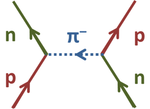Nuclear force: Difference between revisions
imported>John R. Brews (source) |
mNo edit summary |
||
| Line 89: | Line 89: | ||
</ref> | </ref> | ||
}} | }}[[Category:Suggestion Bot Tag]] | ||
Latest revision as of 12:00, 27 September 2024
In physics, the nuclear force is the force holding assemblies of protons and neutrons together.
History
In 1935 Yukawa invented the meson theory for explaining the forces holding an assemblage of neutrons and protons together. The mesons were postulated to exist in three forms: π+, π0, and π– , all of spin zero, today called pions.[1] The behavior of nuclear forces was explained as an exchange of pions.[2] An example is shown in the figure, where the neutron (lower right) emits a pion of negative electric charge to become a positive proton (upper right), while the proton (lower left) absorbs the pion to become a neutron (upper left).[3]
Incidental experimental observation of the muon or μ-meson in 1936 appeared to provide the π– meson needed by the theory, but soon it was found that the muon did not interact with the nucleus and had spin 1/2 (it is a lepton). Later, in 1947, the actual π-meson or pion was discovered, and the pion did interact with the nucleus. Today all three pions have been observed, π+, π–, and π0, the last being the neutral pion found in 1950.[4]
Pion properties
The main pion properties are tabulated below (overscores indicate antiparticles). Symbols u and d refer to the up-quark and the down-quark.
| Symbol | Quark structure | Electric charge (units e) | Spin | Mass (MeV/c02) | Lifetime (s) | Main decay mode |
|---|---|---|---|---|---|---|
| [5] | +1 | 0 | 139.5708 | 2.6033 × 10−8 | ||
| [5] | −1 | 0 | 139.5708 | 2.6033 × 10−8 | ||
| [6] | 0 | 0 | 134.9766 | 0.84 × 10−16 |
In the Standard Model the pions are colorless: the antiquark of the quark-antiquark pair must possess the anticolor of the quark.
Modern formulation
See also the articles Quark and Standard Model
Today a more refined theory of nuclear interactions is based upon the Standard Model. In that model, pions are considered to be quark-antiquark pairs. As indicated in the table above, the π– is a d-quark combined with a ū-antiquark, and a π+ is the other way around, making each the antiparticle of the other. The π0 is a u-quark combined with a ū-antiquark, and therefore its own antiparticle. Because the pions are colorless (the anti-quark in a pion always has the anti-color to the quark, regardless of its flavor), their exchange between nucleons is not a simple color exchange, but a residual color force sometimes referred to as a color van der Waals force, an analogy to the weak electromagnetic attraction between electric charge-neutral atomic complexes.[7][8] In any event, nuclear forces are not considered fundamental today, but are a consequence of the underlying strong forces between quarks, also called chromodynamic forces or color forces. On that basis, nuclear forces are fundamentally based upon color, and only approximated by the Yukawa theory.
References
- ↑ The properties of the pions from a modern standpoint are described in Yorikiyo Nagashima (2010). “§13.2 Pions”, Elementary Particle Physics: Volume 1: Quantum Field Theory and Particles. Wiley-VCH, p. 449. ISBN 3527409629.
- ↑ For an historical outline, see for example Burton Feldman (2001). The Nobel Prize: A History of Genius, Controversy, and Prestige. Arcade Publishing, p. 169. ISBN 1559705922.
- ↑ The corresponding diagram using quarks is found in Charis Anastopoulos (2008). “Figure 8.5: Quarks and strong interactions”, Particle or wave: the evolution of the concept of matter in modern physics. Princeton University Press, p. 299. ISBN 0691135126.
- ↑ Donald H Perkins (2009). Laurie Mark Brown, Max Dresden, Lillian Hoddeson, eds: Pions to Quarks: Particle Physics in The 1950s. Cambridge University Press, p. 95. ISBN 0521100739.
- ↑ 5.0 5.1 K. Nakamura et al. ((2010) and 2011 partial update for the 2012 edition). π±. Particle Data Group. Retrieved on 2011-09-02.
- ↑ K. Nakamura et al. ((2010) and 2011 partial update for the 2012 edition). π0. Particle Data Group. Retrieved on 2011-09-02.
- ↑ Raymond A. Serway, Chris Vuille (2006). Essentials of college physics. Cengage Learning/Brooks Cole, p. 772. ISBN 0495106194.
- ↑ A technical description of the van der Waals color force is found in M Oka and K Yazaki (1984). “Chapter 6: Baryon-baryon interaction from quark-model viewpoint: §3.2 Color van der Waals force”, W. Weise, ed: Quarks and nuclei. World Scientific, pp. 508 ff. ISBN 997196662X.









